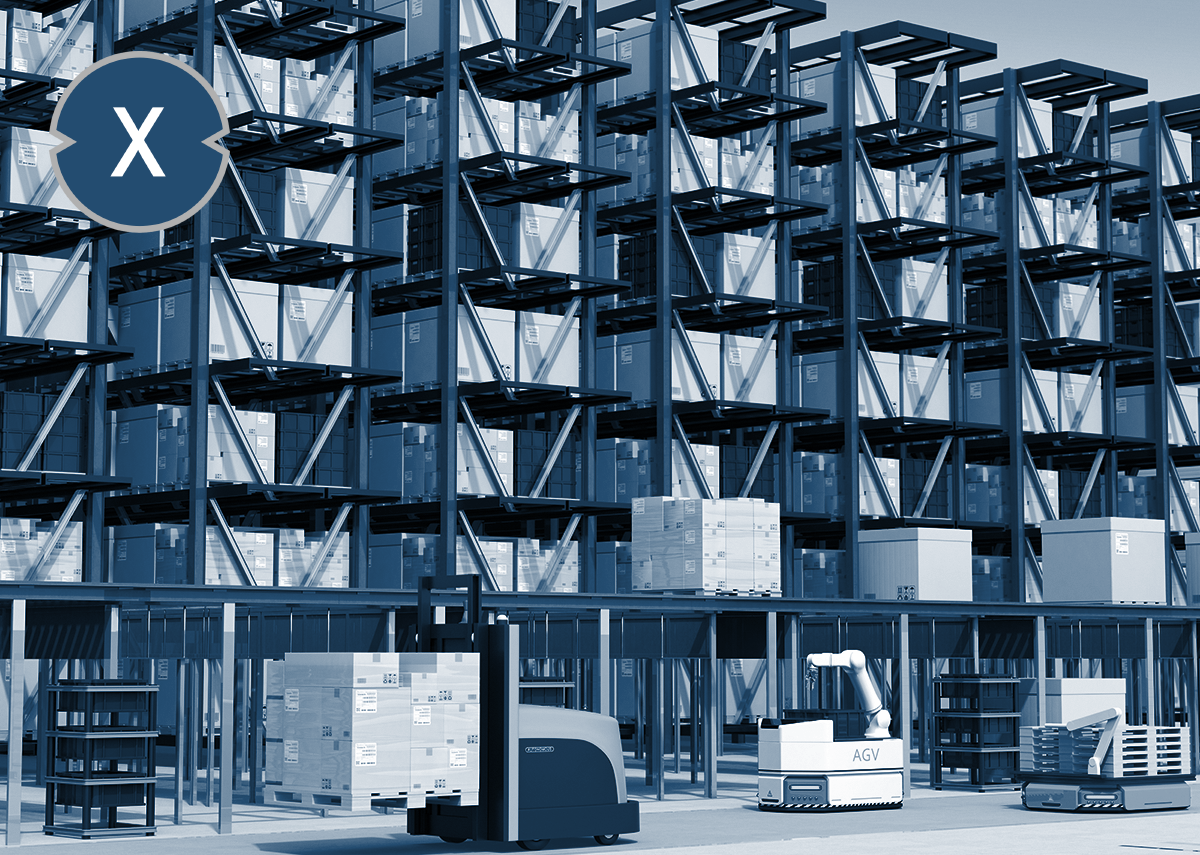A high-bay warehouse (HRL) is a warehouse with shelves from a height of 12 meters; currently the maximum height is approx. 50 meters. The capacity of a high-bay warehouse ranges from a few thousand pallet spaces to several hundred thousand.
It represents a storage system that uses a lot of space and requires high investments to create. These systems are usually managed fully electronically with a warehouse management system. The goods are transported within the warehouse by storage and retrieval machines (RBG). Both flat and long goods can be stored in high-bay warehouses.
📦 Pallet and high-bay storage solutions for logistics managers and warehouse managers
Do you need competent support in implementing your requirements? Do you have questions about Smart Factory, Smart Logistics or digitalization?
🏬 Warehouse optimization and automation for industry, production and trade
The automation of warehouses and supply chains is an essential element of warehouse optimization. We support you in this.
🛒 E-commerce storage solutions for returns, fast shipping (same day delivery) and error-free picking
E-commerce has special requirements and competition is becoming ever stronger. It is not for nothing that e-commerce is considered the driver of changes in the market. With our digital know-how, innovative solutions and implementations are our strength.
High-bay warehouses are usually built from a steel structure. However, it is rarer to find purely wooden rack storage units. There are currently six high-bay timber warehouses in Europe. The highest of these, at 30 m high, is in Kleinheubach. The range of design variants of shelving systems is large. There are numerous mixed forms between a fully automatic high-bay warehouse in a silo design and a manually operated racking system built in a hall. However, we only speak specifically about silo construction when a shelf forms the supporting substructure for the roof and facade.
Storage area in a high-bay warehouse
Here the goods are stored on high racks. Between two rows of shelves there is an aisle in which storage and retrieval machines (RBG) move, e.g. B. can only move in the longitudinal direction of the aisle using rails or induction in order to store and remove goods from the shelves.
The stacker cranes are controlled automatically when picking takes place in the pre-zone (goods to person). However, they can also be operated manually when picking takes place directly on the shelf (person to goods). In the case of a warehouse with automatic operation, this part is protected from human access by means of fences and light barriers for safety reasons.
Each aisle has a storage and retrieval area. In an automatically operated high-bay warehouse, the loading units are moved using conveyor technology and moved to the pick-up and drop-off points for the forklifts. In manually operated high-bay warehouses, the frontmost places on the front of the rack are designed as transfer points to the forklifts.
The pre-zone in a high-bay warehouse
The high-bay warehouse includes a supply or storage area through which the goods are delivered and from which the storage and retrieval machines pick up the goods for storage. Similarly, a removal area is required where the storage and retrieval machines place the goods after removal.
Components of this conveyor technology can be chain conveyors, driven roller conveyors, gravity roller conveyors, lifting tables, turntables, converters, automated guided vehicles, transfer carriages and vertical conveyors. A special feature of the storage and retrieval machines is a truck shuttle system for each storage level, as is the case when used in fully automatic compact storage.
In automatic picking warehouses, picking stations are arranged in the pre-zone. The pallet comes from the high-bay warehouse to the picking station, the goods are removed, booked out and the pallet goes back to the high-bay warehouse.
The goods are also identified in the preliminary zone for the warehouse management system or the material flow computer; this point is referred to as the I point (identification point). The goods are provided with automatically readable identifiers, for example a barcode or smart label, and are managed by the warehouse management system from here until they are booked out.
The management and control of a high-bay warehouse
A high-bay warehouse is managed and controlled by an IT system. The landscape of these systems is very heterogeneous. An ERP system is almost always connected. This often includes a warehouse management system (LVS), which in turn communicates with a material flow computer. The material flow computer controls the conveyor technology in the pre-zone, the storage and retrieval machines and possibly technology in other trades. In less complex systems, the material flow computer is usually integrated into the warehouse management system.
The IT system coordinates the storage and retrieval of goods according to certain guidelines. Optimizing the software to individual requirements is largely responsible for the performance of the warehouse.
Storage is often carried out according to the principle of dynamic warehousing – previously called chaotic warehousing. To put it simply, this means that the system looks for any free space and stores the goods. If necessary, this chaotic principle can be supplemented with rules. For example, you can request that a material that is in several containers be distributed over several rows of shelves in such a way that different storage and retrieval machines can remove the material. This ensures that the material is available even if a stacker crane fails.
The ABC strategy to increase handling performance is also widespread. Here, the most frequently required items are stored in the A area (near the storage/retrieval area) of the warehouse. In the A area, the travel distances are relatively short and so are the storage/retrieval times. Similarly, the B area in the middle distance is used for less frequently used items and the C area in the rear part of the warehouse is used for rarely used items.
It is also possible to distribute the stored goods as equally as possible in terms of weight in order to load the shelf structure evenly.
Automatic storage and collection systems
Suitable for:
Automated storage and retrieval system – AS/RS (Automatic storage and retrieval systems)
More about it here:
Automatic small parts warehouse (AKL)
More about it here:
Suitable for:
Why Xpert.Plus? – Advice and planning for automated pallet high-bay warehouses (HRL) – Build a high-bay warehouse
Xpert.Plus is a project from Xpert.Digital. We have many years of experience in supporting and advising on storage solutions and in logistics optimization, which we bundle in a large network Xpert.Plus
I would be happy to serve as your personal advisor.
You can contact me by filling out the contact form below or simply call me on +49 89 89 674 804 (Munich) .
I'm looking forward to our joint project.
Xpert.Digital – Konrad Wolfenstein
Xpert.Digital is a hub for industry with a focus on digitalization, mechanical engineering, logistics/intralogistics and photovoltaics.
With our 360° business development solution, we support well-known companies from new business to after sales.
Market intelligence, smarketing, marketing automation, content development, PR, mail campaigns, personalized social media and lead nurturing are part of our digital tools.
You can find out more at: www.xpert.digital – www.xpert.solar – www.xpert.plus


